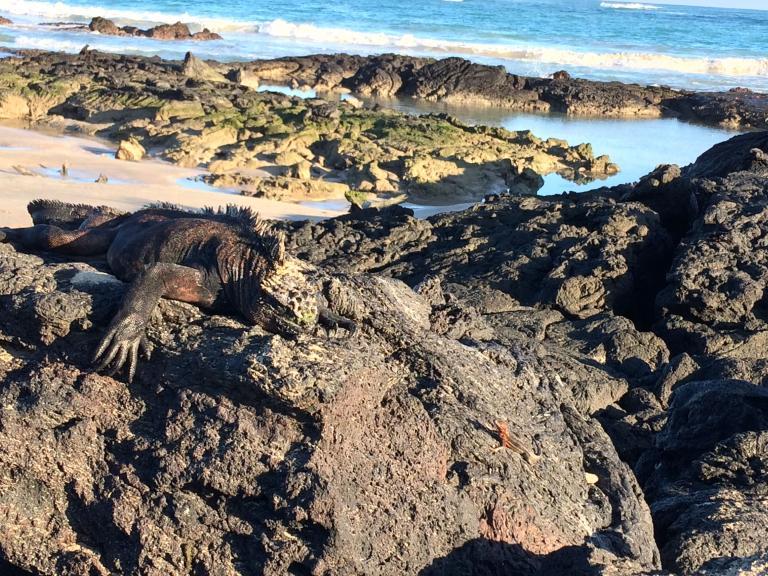
Lead supervisor: Sally Gibson, Earth Sciences
Co-supervisor: Jason Day, Earth Sciences
Brief summary:
Galapagos volcanoes emit a considerable amount of the global volcanic atmospheric SO2 flux but the origin of the sulfur is unknown
Importance of the area of research concerned:
Volcanic emissions constitute a significant source of atmospheric sulfur dioxide (SO2). One of the world’s most volcanically active regions is the Galapagos and observations from space have shown that recent SO2 emissions (104 tons) represent a considerable amount of the global volcanic SO2 atmospheric flux (Carn et al., 2018). These emissions are associated with effusive eruptions from volcanoes in the west of the archipelago (Sierra Negra and Fernandina) but little is known about the source of the sulfur and the role that it places in the magmatic systems that underlie Galapagos volcanoes. The main melt source for the volcanism is an underlying mantle plume and previous investigations have shown that this contains both recycled and primordial components, which exhibit systematic spatial variations in their contributions to melts erupted at Galapagos volcanoes. Additionally, the Pacific Ocean crust beneath Galapagos is rich in sulfides (Gibson et al., 2016) but it is unclear if these crystallised from ascending Galapagos magmas or are fossil hydrothermal sulfides associated with large circulation systems at the nearby Galapagos Spreading Centre.
Project summary :
The main goal of the project is to place improved constraints on the origin of the prodigious amounts of sulfur emitted by Galapagos volcanoes. In order to do this rigorously, a detailed systematic petrographic and geochemical study is required to examine how sulfur (S) is concentrated in Galapagos basalts (e.g. by crystal fractionation and magma chamber replenishment) prior to their eruption. The only recently published work on the S content of the underlying mantle is based on the compositions of basaltic glasses on the adjacent Galapagos Spreading Centre (Ding and Dasgupta, 2017) but these are in an area that is outside the main region of plume influence. These analyses provide important information on the S composition of the depleted Pacific mantle but there remains a large gap in our knowledge as to the S contents of the primary magmas that ‘feed’ Galapagos volcanoes.
What will the student do?:
In order to improve constraints on the role that S plays in magmatic systems beneath Galapagos detailed petrographic and geochemical investigations of Galapagos lavas and xenoliths from a series of volcanoes is required. To place constraints on depths of sulfur saturation, geochemical analyses will be undertaken on glass preserved in olivine- and plagioclase-hosted melt inclusions and also magmatic sulfides (Longpré et al., 2017; Beaudry et al., 2018). This will involve the determination of major, chalcophile (Ag, Cu, S, Se, Sn) and siderophile elements (Co, Mo and Ni) in samples that equilibrated at different pressure intervals in the thickened Galapagos crust. This will allow robust constraints to be placed on both the origin and behavior of S content in the mantle that is supplying melt to Galapagos volcanoes.
References - references should provide further reading about the project:
Gibson S. A., Dale C. W., Geist D. J., Day J. A., Brügmann G. and Harpp K. S. (2016) The influence of melt flux and crustal processing on Re–Os isotope systematics of ocean island basalts: Constraints from Galápagos. Earth and Planetary Science Letters 449, 345–359.
Longpré M.-A., Stix J., Klügel A. and Shimizu N. (2017) Mantle to surface degassing of carbon- and sulphur-rich alkaline magma at El Hierro, Canary Islands. Earth and Planetary Science Letters 460, 268–280.
Carn S. A., Krotkov N. A., Fisher B. L., Li C. and Prata A. J. (2018) First Observations of Volcanic Eruption Clouds From the L1 Earth-Sun Lagrange Point by DSCOVR/EPIC. Geophysical Research Letters 45, 11,456-11,464.
Applying
You can find out about applying for this project on the Department of Earth Sciences page.